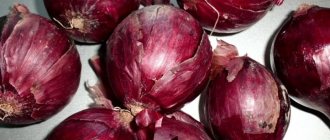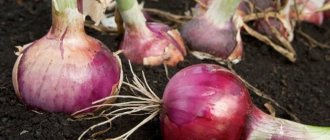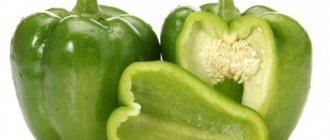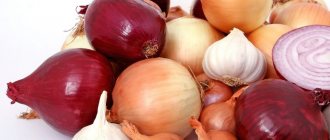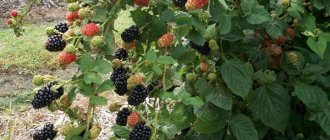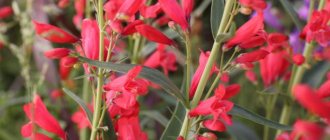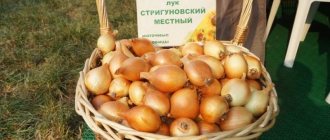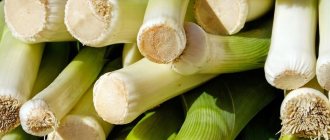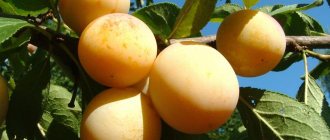general characteristics
The types of perennial onions are so different that they amaze with their characteristics. Onions are mainly grown for greens. Chives are highly decorative, but their leaves are useful and can be eaten, but their taste will be very different from what you are used to. There are types of perennial onions that taste like garlic.
Perennial sprouts are among the first to appear in the beds after the snow melts. Plantings of perennials withstand winter frosts (down to -40 C), the bushes do not freeze.
Chives, chives or decorative onions
Delicate tubular feathers are perfect not only for ingestion, but also for decorating a summer cottage. Many gardeners plant it specifically for the inflorescences (white, purple or pink).
When talking about perennials, you can often hear the word “Allium,” which means decorative onion.
It looks very beautiful together with carnations and bells.
They fit beautifully and are in perfect harmony with other flowers in country flower beds and represent a whole piggy bank of vitamins.
You need to cut at the very base - this preserves more greenery in the garden bed and stimulates the growth of new leaves.
If you only eat leaves, do not let the plant bloom. Although the flowers are also edible, the greens become less flavorful.
Propagated from seeds or by dividing the bush.
Description
Varieties of perennials are grown in different ways: in bushes, in the form of beds or individual rows.
On a note! As a rule, varieties of perennial onions do not form large bulbs, and only greens are used for food.
Distinctive features
Perennial onions are very different from their onion counterparts. Distinctive features:
- Winter hardiness and frost resistance.
- Resistant to onion fly and nematode.
- Grows in one place for several years without transplanting.
- Fruits from early spring to late autumn.
- Suitable for protected and unprotected ground.
- Does not impose special requirements on agricultural technology and soil fertility.
The feathers of young plants are rich in vitamins and microelements. Onion greens are a natural antiseptic and have antiviral properties; it is useful to eat during seasonal ARVI.
Productivity
You can harvest perennials from early spring until the first frost. Feathers are cut from the bushes partially or at one time. Within a few weeks, new greenery grows.
Slime Bow (drooping)
A perennial plant (leaf blades are flat, linear, similar to iris leaves), their length is up to 20-25 cm, width - 8-15 cm and colored green (the shade can be light or dark). The false bulb is shortened (2-2.5 cm in diameter) and covered with light, dry scales. The bush is spreading and branches throughout the growing season.
Slime (dropping) is less pungent and is useful for anemia.
It is recommended to update plantings every 3-5 years. Along with other species, it has not yet become widespread.
Names of species and varieties
Currently, breeders have isolated about five hundred varieties of perennial onions.
Onion
Falve onions have been known and successfully grown in the beds of Russian gardeners for decades. Batun has a number of valuable properties and includes vitamins and microelements.
The onion bush looks sloppy, its decorative properties are weak. The feathers can stretch to a height of up to 70 centimeters, while the stems themselves are wide and delicate. Batun reproduces by arrows. There are different types of batun.
April
April onion is grown both as a perennial and as an annual plant. Distinctive features and properties:
- One of the first to appear in spring from under the snow.
- The first harvest can be harvested at the end of April.
- Increased content of vitamin C.
On a note! Prone to developing arrows. Does not grow well in acidic soils. Sowing the beds is carried out with seeds, using the “bouquet” method.
May
Refers to high-yielding mid-season salad varieties of batun. Representative of domestic selection. The bulbs do not form; they grow the mayweed for greens. Decorative qualities are weak. The taste is sharp and pleasant. High content of vitamins and microelements.
May batun has strong immunity and is resistant to fungal diseases.
Long Tokyo
It is grown throughout our country. The bushes do not need to be replanted for several years without reducing the yield.
Withstands harsh winters without snow. The bulb does not form and is suitable for fresh consumption. The taste is sharp, with a piquant bitterness.
Tenderness
Forms a small spreading bush of small height, up to 40 centimeters. The feathers are tubular with a slight waxy coating. It winters well without additional shelter, is not afraid of temperature changes, and has good taste characteristics. Increased content of ascorbic acid.
Seryozha
Used for greens, it does not form an onion, although it is considered an interspecific hybrid of the baton onion and its fellow onion. The feathers are long, juicy, with a characteristic bluish tint. The taste of greens is sweet, rich, slightly spicy.
It is grown only by seedlings. Hilling up and seasonal feeding are mandatory activities.
Fat-leaved
An early ripening variety of domestic selection. It is characterized by winter hardiness and high growth rates of fresh greenery after pruning. The bush is semi-spreading, the bulb does not form. The stems are hollow, very juicy, suitable for making salads. High content of ascorbic acid.
Slime Bow
A highly decorative type of onion, planted in flower beds and garden beds. The second name is drooping onion. It can be consumed fresh, as well as canned, dried and pickled.
Green stems remain tender and do not become rough until late autumn. The leaves are thick, wide and fleshy. Rich in microelements, high iron content in onion stems. Used as a folk healer: it pacifies pain, fights inflammation and fatigue.
Green
A high-yielding variety grown everywhere. Does not have any special care requirements. Forms compact small bushes. The stems are flat, wide, juicy, the taste is delicate with a slight garlicky smell.
Dwarf
Frost-resistant variety of slime, mid-season. The stems are wide with a slight waxy coating. It is distinguished by its compact bushes: the height of an adult plant is no more than 30 centimeters. Belongs to salad varieties, grown in flower beds and beds. Fruits until late autumn. Grows well in any soil, does not require watering, and tolerates drought.
Leader
Universal purpose. The bushes require watering and regular loosening. After cutting, new stems grow on the 40th day. Tolerates frosts down to -30 C.
Charm
Excellent as a decor due to the unusual beautiful flowers reminiscent of snow-white fluffy balls. The yield of the variety is average, the bushes are small and compact.
Simbir
Recommended for cultivation on private plots. Simbir is winter hardy. The shape of the sheets is original - the plates are slightly twisted in the shape of a spiral. The variety is mid-season, with high yield.
Salad
Belongs to mid-season winter-hardy varieties. The purpose of greenery is universal, the yield is above average. It has excellent taste characteristics and a pleasant light garlic aroma.
A treasure trove of health
Long-term yield is combined with high productivity. The greens are tender, mildly spicy, spicy, with an unobtrusive garlic smell. Belongs to early ripening varieties. Possible to grow in flower beds.
Waltz
A new variety released in 2015. Ripens quickly, the leaves are twisted into an original spiral. Does not require replanting for 5 years without loss of yield. It is winter hardy and resistant to fungal diseases.
Multi-tiered
Horned onion is the colloquial name for a multi-tiered type of perennial onion. It was brought to the beds of Russian gardeners from China. The “horned” relative differs from the batun in the type of flower arrow; the greenery looks like an onion.
See also
When to remove onions in 2021 in the Moscow region and the Moscow region from the garden for storage
Read
The main stem of a multi-tiered onion ends in small onions. This is the first tier. Root bulbs should not be eaten. Chinese onions do not accumulate nitrates and contain a large amount of useful components and vitamins. This species does not have a “resting” mode; greens can be collected without interruption.
Likova
One of the most popular varieties of multi-tiered onions among Russian gardeners. The upper bulbs ripen to a large size. The shape is round. Likova is classified as an early ripening variety. Prefers neutral soils and plenty of sunlight.
Memory
A productive variety of perennial onion. The upper tier is formed from four bulbs of an original violet-burgundy color, elongated in shape. There is a high content of carotene in fresh greens.
Chelyabinsk
Considered a super early variety. The stems are distinguished by high taste characteristics: juicy, tender leaves with a slight pungency. Chelyabinsk perennial onions are not afraid of frost and harsh winters with little snow. Resistant to a wide range of fungal diseases.
Chives
Known since the Middle Ages, where it was used as a medicine and a decorative element for flower beds. It is especially valued in European countries.
Chives means “pruned onion” (translated from German). In common parlance it is often called restaurant onions or chives. It is a small bush with thin delicate leaves and a powerful rhizome. Flower-bearing arrows are beautiful with bright purple inflorescences. Often planted as a hedge or border crop.
Bohemia
The variety is high-yielding. Without transplanting, it can be grown in one place for five years. Capable of producing greens all year round if grown indoors or in a greenhouse. It has high decorative qualities and is a honey plant.
Honey plant
Belongs to Russian selection. It has excellent taste; the stems have a delicate, juicy taste with a spicy pungency. The honey plant is resistant to peronospora.
Chemal
Capable of producing up to 7 kilograms of greenery in one growing season. At the same time, it forms a small compact bush; the leaves grow back quickly after cutting. The taste of greens is pungent. The disadvantage is susceptibility to powdery mildew.
Spring
Forms a powerful, strong, tall bush. Tolerates frost and has good immunity. Productivity is up to 6 kilograms of greens per season, the taste is juicy, with a slight pungency.
Crocus
An early ripening variety of perennial onion. Frost resistance is average, does not tolerate winters with little snow, the yield is high, the stems grow quickly after cutting. It has a high content of vitamin C in fresh leaves.
Shallot
A variety of onion. Brought to Russia from Europe, native to the Middle East. There are several other names: family, Alexandrian, escalot. It is a representative of two-year-old onions. From the seeds, seed onions are grown, which are planted the following year to obtain a full harvest. One seed bulb ripens into a large “family” consisting of 5-6 new bulbs.
Airat
Medium-ripened shallots. The bulbs are yellow in color with a spicy, pungent taste, and have an elongated shape. Capable of raising up to 5 children in an onion family.
Pomegranate
Family onion with early ripening. Resistant to yellowing of leaves, it is able to delight gardeners with delicious fresh herbs for a long time. Red onions, weighing up to 40 grams.
Sturdy
Heirloom onions designed for long-term storage. The bulbs ripen large, oval, pale red in color. The robust plant is distinguished by its ability to resist fungal diseases and is resistant to the formation of shoots.
Vitamin basket
Super early ripening variety. Forms several onion families of 4-5 bulbs each. The color of ripe onions is pale golden. Differs in the ability for long-term storage. Strong immunity to fungal and bacterial diseases.
Emerald
Late-ripening variety intended for long-term storage. Forms 4-5 bulbs in one family, flattened in shape, weighing up to 35 grams. The color when fully ripe is brown-red.
Other types
In addition to the above varieties of perennials, there are other species and varieties belonging to the onion family.
Oblique bow
Commonly known as bitter garlic. Oblique onions received this name for their resemblance to real garlic bushes. It is often used in decorating flower beds and vegetable beds because of its beautiful and original inflorescences. The root bulb cannot be eaten; the greens are suitable for preparing salads and decorating dishes.
Giant
The leaves are juicy, without a waxy coating, suitable for canning and cutting for greens. Able to live in one place without transplanting for more than 5 years. It has good winter hardiness.
Newbie
Winter-hardy variety of oblique onions. The leaves can be pickled and eaten fresh. Grows without loss of yield in one place for more than 10 years. Requires sunlight and is easy to care for.
fragrant onion
Used as a seasoning. The second name is Jusay. Popular in Asia, the Middle and Far East. In Russia it is grown as a border plant and in spice beds.
Note: When grown next to berry bushes, it protects plants from aphids and other insect pests..
The bush is low-growing with a horizontal rhizome. A wonderful honey plant. The inflorescences are formed on the arrows and have a pleasant strong aroma. The leaves are flat, not tubular. The arrows, like the leaves, are eaten.
Witch Doctor
Winter-hardy fragrant onion. Produces fresh greens from early spring to late autumn. Honey plant. The leaves are tasty, mildly pungent, and high in iron and fiber.
Fragrant
High-yielding variety with a pronounced garlic aroma. It is characterized by high winter hardiness. Does not require complex agricultural technology and regular care. An excellent seasoning for soups and preserves.
Spicy
Salad variety of medium late ripening. Not afraid of cold weather and temperature changes. Delicious seasoning for salads and soups. Used as part of a flower arrangement on alpine slides.
Altaic
Representatives of this type of onion are listed in the Red Book and are not very common. Grows on soils enriched with calcium and rocks. The second name is rocky or mountain onion. Externally, the Altai onion looks like a batun, is capable of forming up to 30 bulbs on one bush, and has a powerful root system.
Blushing
In Russia, it is distributed in the Caucasus and Crimea. It has high decorative qualities due to its beautiful inflorescences. Forms a low bush, up to 40 centimeters high.
Aflatunsky
Inflorescences in the form of huge purple balls. Forms a bush up to 1 meter high. High decorative qualities. Not afraid of prolonged drought and frost. Honey plant. The bulbs are rich in phytoncides that have an antiviral effect.
Features of cultivation
The variety and type of representative of the onion family is chosen to suit the growing region and the gardener’s goals: fresh herbs, a harvest of bulbs or decoration of alpine hills and flower beds.
See also
When to harvest onion sets, family and turnips from the garden in the Urals in 2020, timing
Read
Planting and transplanting
Perennial onions are easy to grow. It is important to choose the right place, because this onion does not like transplanting. As a rule, perennials are planted as seedlings in pre-prepared soil and a selected area. The onion should take root quickly, but suddenly something goes wrong, the plant grows slowly, turns yellow, and begins to fade. In this case, try replanting the plant.
The bush is dug up along with a lump of earth and transferred to a new place. It is important to take into account all the mistakes of the first landing.
Site selection
The site should be sunny, soil with a neutral pH. Stagnation of water at the roots is not allowed; the location of the bed should not be in a lowland. Shadow is also undesirable.
Neighboring onion beds can include berry bushes, flower beds, or other herb plants.
Crop rotation predecessors can be anything other than other members of the onion family.
Soil preparation
The soil can be prepared in the fall: dig deep with compost and wood ash. In spring, the beds are loosened and a little superphosphate is added. It is advisable to disinfect the soil with potassium permanganate or scald it with boiling water.
It is necessary to determine the acidity of the soil using litmus paper. If the acidity is high, it is necessary to liming using slaked lime or chalk. Onion plants do not like weeds; they must be removed during autumn and spring digging.
Important! You cannot add fresh manure to the beds; the onions will get burned, turn yellow and die. .
Planting scheme
Many types of perennial onions are grown as border plants. The distance between bushes depends on the width of the mature bush being formed.
Family onions are planted according to the principle of planting onion sets, but the interval between onions is increased for a “large family” to 15-20 centimeters.
Deadlines
Perennial onions are planted in autumn or early spring. The choice of timing depends on the purpose of planting and the purpose of the onion beds. Onions are sown for seedlings in mid-March; young seedlings can be planted in the ground from the end of April. The soil temperature should reach +10 C. Planting dates may vary depending on the region and climatic conditions.
Mulching
The spaces between the onion rows are covered with mulch as a preventive measure against weeds and to save moisture. The best option is sawdust, straw or sand.
Dividing the bush
An excellent way to propagate perennial onions is by dividing the bush. The procedure is best carried out in August. The plant is carefully divided, trying not to damage the root system, and transplanted to a new location.
Care
Perennials do not require complex care. If you choose the right place in advance, caring for the plants will consist of weeding and loosening. Watering is usually adjusted to the rainy season.
Weeding and loosening
It is recommended to loosen the rows after watering. All weeds must be removed. Beds overgrown with weeds reduce yields by 3-4 times.
Watering
After planting plants in the ground, watering is required. Water should not get on the leaves; it is better to water at the root. In the future, onions cannot tolerate excessive moisture and excess moisture at the roots. An outbreak of fungal diseases begins, the leaves turn yellow, and the perennial withers.
The irrigation system is adjusted to current weather conditions.
Protection from diseases and pests
Perennials are susceptible to standard onion diseases: downy mildew, rust, onion fly and thrips. Plants should be regularly inspected for signs of disease.
Preventative treatment includes:
- Spraying the leaves with a solution of brilliant green: 10 drops per 10 liters of water.
- Sprinkling plants with wood ash in windless, dry weather.
- Compliance with crop rotation rules.
- Timely removal of weeds.
- Perennial onions are planted away from annual ones.
In general, perennials are unpretentious; if the location is chosen well, they do not get sick and do not cause difficulties in care.
Top dressing
Perennial onions do not need special feeding. A one-time watering of the beds with bird droppings or mullein infusion during the period of active growth is sufficient.
Preparing for winter
In late autumn, perennials are pruned, the bushes are covered with humus and mulched with straw and sawdust. Plants with poor frost resistance can be covered with spruce branches, which are immediately removed in the spring after the snow melts.
Properties of culture
There are a huge number of varieties of green onions. They differ in taste, appearance, ripening period and cultivation characteristics. Each variety description has its own nuances that must be adhered to in order to get a good harvest. Due to their attractive appearance, onions are often grown as an ornamental plant. Gardeners value onions because of their ability to ripen early.
The plant contains amino acids and vitamins that the human body needs. The main purpose of planting green onions is to obtain greenery. Onions improve digestion, have a positive effect on metabolic processes and increase the protective properties of the immune system. The vegetable lowers cholesterol levels and removes toxins from the body.
Harvest and storage
To achieve long-term storage of the crop, it is necessary:
- Dry the onion and treat it with an ultraviolet lamp.
- Meet harvest deadlines.
- Stop watering 2-3 weeks before harvest.
- Peel and discard onions before storing.
Not all types of perennials form bulbs and are suitable for long-term storage. This factor must be taken into account when choosing a variety. As a rule, perennials are grown for greens.
Recommendations for selection
If a gardener chooses a perennial to grow for decorative purposes, it is recommended to pay attention to the following types:
- Fragrant onion.
- Aflatunsky.
- Oblique.
When growing for turnips:
- Shallot.
For herbs and seasonings:
- Fragrant.
- Batun.
- Slime.
- Multi-tiered.
- Chives.
Some species will fit perfectly into flower beds and alpine hills and will bring fresh fragrant greenery throughout the spring and autumn period.
Subtleties of growing winter varieties
Planting onions before winter has been practiced by gardeners for many years. It is important to choose the right variety. In cold winters with little snow, all plantings may freeze out. Features of care:
- Mulching the beds with humus mixed with sand.
- For the winter, the plantings are covered with fallen leaves or spruce branches.
- In the spring, after the threat of frost has passed, the beds are cleaned and loosened.
Growing winter onion varieties is preferable in southern regions with a temperate climate and relatively warm winters.
Growing by seeds
Any type of onion can be grown from seeds. The peculiarity of the method is that the seed must be fresh, collected no earlier than a year before planting. The germination rate of onion seeds drops quickly.
You can grow seedlings from seeds or plant grains directly into the ground. Pre-sowing preparation includes:
- Calibration and rejection of seed material.
- Seed disinfection.
- Soil preparation and disinfection.
- Soaking and germination.
The timing of sowing depends on the method of cultivation: seedling or non-seedling method, as well as the region of cultivation and natural and climatic conditions.
Breeding technology
There are several technology options for breeding perennial onions.
Seeds
Planting of perennial onions into the soil occurs in spring or late autumn (before winter). This rule affects how quickly seedlings emerge.
When sown in open soil in spring, the plant will hatch after 14 days. In this case, the crop grown from seeds will develop slowly. At the same time, the gardener should not lose sight of the onion. Experienced specialists, in order to avoid a long germination process, resort to the seedling method. The method includes several stages. Firstly, the planting material is washed in potassium permanganate and soaked for 24 hours in warm water. Secondly, surface sowing of onions in seedling containers is carried out.
For the development of culture, it is necessary to provide appropriate temperature conditions. The air should warm up to +20-22C until shoots appear and to +18-20C from the moment they appear. The seedlings sprout within two months. The seedlings are transplanted in May. Before planting in open ground, the soil is loosened, drained and, if necessary, fertilized.
To obtain early greenery, sowing is done before winter. When the thermometer drops a couple of degrees in autumn, seeds are sown thickly. The norm increases by 25%. This planting will allow you to get seedlings 14 days earlier in the spring. Another advantage of the method: low temperature conditions prevent rapid bolting of the crop. For this reason, it is possible to collect succulent feathers of perennial onions for a long time.
Root division
Typically, gardeners divide bulbs in mid-spring or late summer. To do this, roots are taken from adult specimens of perennial onions and the fruits are divided so that each has one mature shoot.
Planting is done in the following beds: 20x70 with onions deepened 8 cm into the soil.


